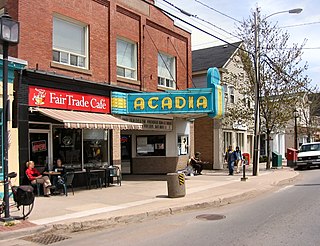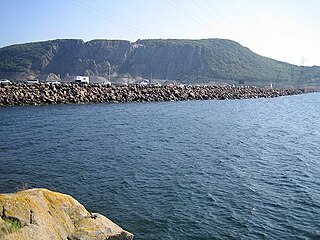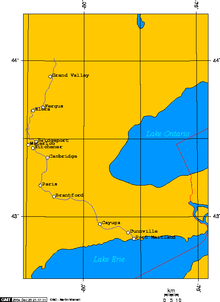
Wolfville is a near silent Canadian town in the Annapolis Valley, Kings County, Nova Scotia, located about 100 kilometres (62 mi) northwest of the provincial capital, Halifax. The town is home to Acadia University and Landmark East School.

The Bay of Fundy is a bay between the Canadian provinces of New Brunswick and Nova Scotia, with a small portion touching the U.S. state of Maine. It is an arm of the Gulf of Maine. Its tidal range is the highest in the world. The name is probably a corruption of the French word fendu, meaning 'split'.

The Canso Causeway is a 1,385 m (4,544 ft) rock-fill causeway crossing the Strait of Canso, provides access by road to the Atlantic Ocean, to the Gulf of St. Lawrence or Cape Breton Island to the Nova Scotia peninsula.

Yarmouth is a port town located on the Bay of Fundy in southwestern Nova Scotia, Canada. Yarmouth is the shire town of Yarmouth County and is the largest population centre in the region.

The Minas Basin is an inlet of the Bay of Fundy and a sub-basin of the Fundy Basin located in Nova Scotia, Canada. It is known for its extremely high tides.

East Hants, officially named the Municipality of the District of East Hants, is a district municipality in Hants County, Nova Scotia, Canada. Statistics Canada classifies the district municipality as a municipal district.

The Shubenacadie Canal is a canal in central Nova Scotia, Canada. It links Halifax Harbour with the Bay of Fundy by way of the Shubenacadie River and Shubenacadie Grand Lake. Begun in 1826, it was not completed until 1861 and was closed in 1871. Currently small craft use the river and lakes, but only one lock is operational. Three of the nine locks have been restored to preserve their unique fusion of British and North American construction techniques. More extensive restoration is planned.

Port Maitland is a small community in Yarmouth County, Nova Scotia, Canada. It is near the town of Yarmouth, and very near to the community of Beaver River. Salmon River also very nearby, lies within Digby County. The community covers 81.46 km2 (31.45 sq mi).

The Annapolis River is a Canadian river located in Nova Scotia's Annapolis Valley.

The Shubenacadie River is a river in Nova Scotia, Canada. It has a meander length of approximately 72 km from its source at Shubenacadie Grand Lake to its mouth at the historic seaport village of Maitland on Cobequid Bay, site of the building of the William D. Lawrence, the largest wooden ship ever built in Canada. In 2009, the I Backpack Canada blog named the Shubenacadie one of the top five whitewater rivers in Canada. The lower 30 km of the river is tidal and the river experiences a tidal bore twice daily, with some bores reaching up to 3 m in height at certain points along the river. Local tourism operators offer adventure seekers a chance to ride with the bore on high-horse power Zodiac Hurricanes. Tidal Bore Rafting was invented at the Tidal Bore Rafting Resort by H. Knoll. It is also a popular surfing spot for experienced sea kayakers.
The Shubenacadie Valley is a Canadian rural region in central Nova Scotia.
Area codes 902 and 782 are telephone area codes in the North American Numbering Plan (NANP) for the Canadian provinces of Nova Scotia and Prince Edward Island. Area code 902 was one of the nine original North American area codes in Canada established in October 1947. Area code 782 was added to the numbering plan area in August 2014, to form an overlay complex in relief to prevent telephone number shortages.
Aylesford, since its formation, has always been a farming community. It is situated in western Kings County in the Annapolis Valley of Nova Scotia, Canada. The settlement was named after the fourth Earl of Aylesford, Heneage Finch, who was Lord Of The Bedchamber to George III from 1772-1777. The community is located between the North and South Mountains, and is roughly a 15 minute drive to Canadian Forces Base Greenwood, and a 10 minute drive to its closest neighbour, the Town Of Berwick. Aylesford is located on the Evangeline Trail scenic tourist route, which was named after the epic 1847 H.W. Longfellow poem entitled Evangeline, A Tale of Acadie.

Yarmouth, officially named the Municipality of the District of Yarmouth, is a district municipality in Yarmouth County, Nova Scotia, Canada. Statistics Canada classifies the district municipality as a municipal district.
Grand River Naval Depot was a planned base on Lake Erie in what is now Port Maitland, Ontario, Canada.

The Cornwallis River is in Kings County, Nova Scotia, Canada. It has a meander length of approximately 48 kilometres (30 mi) through eastern Kings County, from its source on the North Mountain at Grafton to its mouth near Wolfville on the Minas Basin. The lower portion of the river beginning at Kentville is tidal and there are extensive tidal marshes in the lower reaches. In its upper watershed at Berwick, the river draws on the Caribou Bog while a longer branch continues to the official source, a stream on the North Mountain at Grafton.
Maitland, East Hants, Nova Scotia is a village in East Hants, Nova Scotia. It is home to the historic Lawrence House Museum, which is part of the Nova Scotia Museum. The William D. Lawrence ship was built here. The community was part of the Douglas Township until it was named Maitland after Lieutenant Governor of Nova Scotia Peregrine Maitland (1828–34) when building the Shubenacadie Canal was first attempted (1826–1831). The Canal was supposed to start at Maitland, Nova Scotia and run through the province to Maitland Street, Dartmouth, the canal being "bookended" by two "Maitland" landmarks.

South Maitland is a community in the Canadian province of Nova Scotia, located in the Municipal District of East Hants, Hants County, Nova Scotia. The community was one of the stops on the Shubenacadie Canal system and the site of a number of 19th century shipyards including the yard that built the barque Calburga in 1890, the last large square rigger to sail under a Canadian flag. The village is best known for the historic bridge built over the Shubenacadie River, a large bridge built over challenging tidal waters by the Midland Railway, part of the Dominion Atlantic Railway in 1901. Demolished in the 1990s, a surviving abutment of the railway bridge was retrofitted in 2006 by the Fundy Tidal Interpretive Centre at South Maitland as an interpretive lookoff and walking trail showcasing the massive tides of the Shubenacadie River. A former railway caboose is also preserved beside the interpretive tail.
St. Georges Bay is a bay with shore on the Nova Scotia peninsula and Cape Breton Island, Canada, thus comprising a sub-basin of the Gulf of St. Lawrence.














